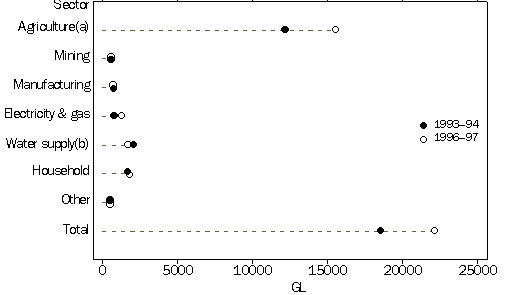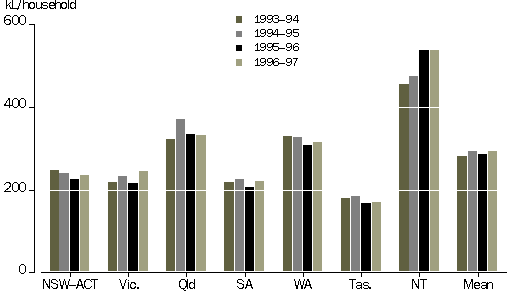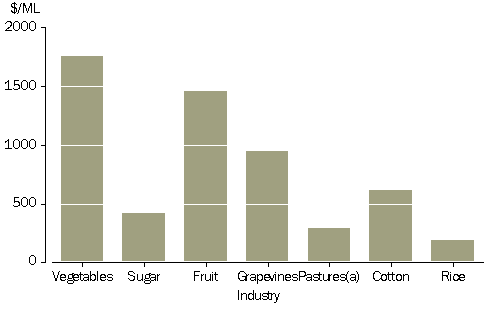|
|
INTRODUCTION
Water is a key resource in Australia. Not only is Australia one of the driest continents, it is also characterised as having a high spatial and temporal variability in climatic conditions. This variability, combined with high levels of evapotranspiration, and a limited supply of water resources in major agricultural and urban areas, makes the supply, use and management of Australia's water resources a major issue for water users, water managers and policy makers.
The Water Account is part of a series of physical environmental accounts that are being developed by the Australian Bureau of Statistics, focusing on the quantitative characteristics of Australia's water resources. The Water Account presents updated information which has not been reported on a comprehensive basis since the 1985 Review of Australia's Water Resource and Water Use (AWRC 1987a; AWRC 1987b). Detailed statistics have been compiled depicting the supply, use and consumptive use of water by various industries and sectors for Australia and for each State and Territory. Water reuse and discharge data are also presented. In addition, data on the volume of surface water and groundwater assets have been compiled for Victoria.
The Water Account focuses on four financial years: 1993-94, 1994-95, 1995-96, 1996-97 and will provide vital information to a number of water management initiatives such as the:
- Council of Australian Governments (COAG) Water Reform Framework
- State of the Environment Reporting
National Water Quality Management Strategy and programs funded through the Natural Heritage Trust Program such as the:
- National Land and Water Resources Audit
- National River Health Program
- National Rivercare Program; and the
- Murray Darling 2001 Program.
SUMMARY RESULTS
Water Supply, Use and Consumption
In 1996-97 an estimated 68,703 GL of surface and groundwater was extracted from the environment, of which 11,525 GL was distributed for use via mains infrastructure (table 1). Discharge of water back to the environment (directly to surface waters) totalled 49,480 GL, of which 46,509 GL was utilised in-stream by hydro-electric power generation schemes. Net water consumption, therefore, was 22,186 GL. (Net water consumption refers to the amount of water used and not discharged back to existing water bodies).
1. SUPPLY, USE AND CONSUMPTION OF WATER, Australia 1996–97
| Sector | Self Extracted Use (ML) | Mains Supply (ML) | Mains Use (ML) | In-stream discharge (ML) | Net Water
Consumption (ML) (a) |
|
| Agriculture | 7,156,488 | – | 8,346,485 | – | 15,502,973 |
| Services to Agriculture; hunting and trapping; Forestry and Fishing | 13,164 | – | 14,420 | 8,589 | 18,815 |
| Mining | 544,706 | 4,905 | 30,376 | – | 570,217 |
| Manufacturing | 216,666 | 511,071 | – | – | 727,737 |
| Electricity and Gas | 47,771,365 | 12,869 | 58,387 | 46,509,049 | 1,307,834 |
| Water Supply; sewerage and drainage | 12,864,431 | 11,507,477 | 349,691 | – | 1,706,645 |
| Other | 103,588 | 282 | 419,207 | – | 522,513 |
| Household | 32,923 | – | 1,796,076 | – | 1,828,999 |
 |  |  |  |  |  |
| TOTAL | 68,703,371 | 11,525,533 | 11,525,533 | 46,517,638 | 22,185,733 |
|
| (a) Net Water Consumption = Self Extracted Use + Mains Use - Mains Supply - In-stream Discharge |
Over the four years from 1993-94 to 1996-97 total net water consumption has risen 19% from 18,575 GL to 22,186 GL (graph 2). During this period net water consumption has been variable with 21,142 GL consumed in 1994-95, and 19,875 GL consumed in 1995-96. A majority of the rise (3,434 GL) is accounted for by the agriculture sector, with a significant increase in the livestock, pasture, grains and other agriculture sector, and to a much lesser extent the cotton and rice industries (graph 3).
2. NET WATER CONSUMPTION, By Sector 1993-94, 1996-97

(a) Agriculture includes services to agriculture, hunting and trapping; and forestry and fishing.
(b) Includes sewerage and drainage services.
In 1996-97 the agriculture sector accounted for the majority of net water consumption. Total agricultural net water consumption was 15,522 GL, which comprised 70% of the total net water consumption for Australia. The livestock, pasture, grains (excluding rice) and other agriculture sector consumed 8,795 GL. Other agriculture sectors combined had a net water consumption of 6,726 GL (graph 3). The household sector and water supply, sewerage and drainage services industry were the next largest consumers of water, with consumption for 1996-97 totalling 1,829 GL and 1,707 GL respectively (each comprising 8% of total water consumption for that year). Water use by the water supply, sewerage and drainage services industry may include their own consumptive use, transmission losses and releases for environmental flows.
3. NET WATER CONSUMPTION, Agriculture 1993–94, 1996–97

(a) Includes livestock, pasture, grains (excluding rice) and other agriculture
Household Water Use
In 1996-97 household water consumption totalled 1,829 GL, or 8% of the total water consumption in Australia. This resulted in a mean household water use of 294 kL/year in 1996-97, up from 282 kL/year in 1993-94. Total household water consumption was largest in NSW/ACT (32% of household water consumption in 1996-97), Victoria (23%) and Queensland (23%), with South Australia, Western Australia, Tasmania and the Northern Territory consuming the remaining 22%. Mean water use per household was highest in the Northern Territory (500 kL/year), Queensland (340 kL/year) and Western Australia (320 kL/year) (graph 4). Mean household water use in NSW/ACT, Victoria and South Australia was between 218 and 237 kL/year. Tasmania had the lowest mean household water usage of 176 kL/year.
4. HOUSEHOLD WATER USE, Australia

Water Use and the Economy
The agriculture sector is the most intensive user of water with an industry gross product (IGP) of $588/ML of water use in 1996-97 (includes IGP for both dryland and irrigated agriculture). This contrasts with the less intensive service industries sector (excluding utilities) which had an IGP per ML water use totalling $382,000/ML. All other sectors fall between these two extremes, with the utilities sectors (water supply, sewerage and drainage; and the electricity and gas industries) being the next most water intensive (graph 5).
5. INDUSTRY GROSS PRODUCT(a), per ML Water Used, 1996/97

(a) Industry Gross Product is a measure of the gross product of a business, defined as the gross output minus intermediate inputs
The value of irrigated production accounted for approximately 26% of the total gross value of production from agriculture which was estimated at $28,156 million in 1996-97 (table 6). Irrigated pasture covered the largest area of irrigated land, accounting for approximately 935,000 hectares; it is a major contributor to the livestock, pasture, grains and other agriculture industry group.
The vegetable and fruit industries returned the highest gross value per ML water used for irrigated agriculture, at $1,760/ML and $1,460/ML respectively (graph 7). The water intensive activity of rice growing resulted in the lowest ratio of gross value per ML water used ($189/ML), followed by $289/ML for irrigated pastures, other grains and livestock.
6. WATER USE AND GROSS VALUE FOR IRRIGATED AGRICULTURE
|
| Industry | Gross value ($m) | Net water use (ML) | Irrigated area (ha) |
|
| Livestock, pasture, grains and other agriculture | (a)2,540 | 8,795,428 | 1,174,687 |
| Vegetables | 1,119 | 634,913 | 88,782 |
| Sugar | 517 | 1,236,250 | 173,224 |
| Fruit | 1,027 | 703,878 | 82,316 |
| Grapes | 613 | 648,574 | 70,248 |
| Cotton | 1,128 | 1,840,624 | 314,957 |
| Rice | 310 | 1,643,306 | 152,367 |
 |  |  |  |
| Total | (b)7,254 | 15,502,973 | 2,056,580 |
|
| a) Comprises of: stock products from irrigated agriculture (excluding milk) have a gross production value of $148 million; milk products from irrigated agriculture have an estimated gross production value of $1,259 million; and irrigated crops (mostly cereals) within this category have an estimated gross production value of $1,133 million. |
| (b) The gross value of production for agriculture including dryland and irrigation farming is $28,156 million. |
7. GROSS VALUE PER ML WATER USED, by Irrigated Agriculture

(a) Includes livestock, pasture, grains (excluding rice) and other agriculture
MAIN FINDINGS
- In 1996-97, net water consumption in Australia totalled 22,186 GL. Consumption in previous years totalled 18,575 GL in 1993-94; 21,142 GL in 1994-95; and 19,875 GL in 1995-96.
- The majority of water consumption occurred in NSW/ACT (39%), Victoria (30%) and Queensland (17%). South Australia, Western Australia, Tasmania and the Northern Territory combined consumed the remaining 14%.
- The agriculture sector was the largest consumer of water, totalling an estimated 15,503 GL which represented 70% of total water consumption during 1996-97.
- Livestock, pasture and grains (excluding rice) consumed 8,795 GL of irrigated water in 1996-97. Cotton, rice and sugar each consumed 1,841 GL; 1,643 GL; and 1,236 GL respectively in 1996-97.
- Rice was the most water intensive industry, with an irrigated gross value of $189 per ML of water used. Irrigated pastures, other grains and livestock returned an average value of $289 per ML of water used. The next most intensive water users included irrigated sugar and cotton, with gross values of $418 per ML and $612 per ML respectively.
- Household water consumption totalled an estimated 1,829 GL during 1996-97, representing 8% of total water consumption for that year. Household water consumption for the three previous years totalled 1,704 GL (1993-94); 1,800 GL (1994-95); and 1,691 GL (1995-96).
- Mean household water use was highest in the Northern Territory (500kL/year), Queensland (340kL/year) and Western Australia (320kL/year). Tasmanian households used the least amount of water (average 176kL/year), while NSW/ACT, Victoria and South Australia used between 218 and 237 kL/year.
- Water supply, sewerage and drainage services used 1,707 GL (8% of total water consumption) in 1996-97. Most of this amount is conversion losses and environmental flow allocations, where these have been measured. In previous years, this sector has used over 2,000 GL or 10% of total water consumption.
- Net water consumption by the electricity and gas sector totalled 1,308 GL in 1996-97. This amount excludes in-stream used for hydro-electricity generation.
- In-stream use of water for hydro-electricity power generation totalled 46,509 GL in 1996-97; most of which occurred in Tasmania.
- Effluent reuse totalled 134,424 ML in 1996-97. The largest users of effluent reuse were the mining sector (41,811 ML-31% of the total effluent reuse) and agriculture (38,118 ML-28% of total effluent reuse).
- Mining consumed 570 GL of water, or around 3% of total water consumption for 1996-97. Most of this was self-extracted from surface and groundwater sources, with only a small amount (approximately 30 GL) supplied through mains infrastructure.
Further State and industry breakdowns as well as other information relating to the supply and use of water in Australia are available in Water Account for Australia, 1993-94 to 1996-97. Australian Bureau of Statistics Catalogue No. 4610.0
REFERENCES
AWRC 1987a, 1985 Review of Australia's Water Resources and Water Use. Vol. 1: Water Resources Data Set, AGPS, Canberra.
AWRC 1987b, 1985 Review of Australia's Water Resources and Water Use. Vol. 2: Water Use Data Set, AGPS, Canberra.
|
 Print Page
Print Page
 Print All
Print All